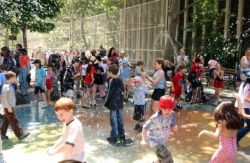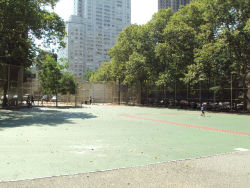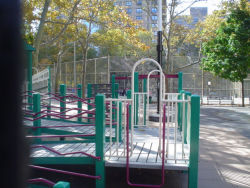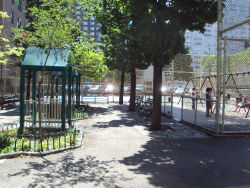Matthew P. Sapolin Playground
Matthew Sapolin Playground
What was here before?
Owned by the Dyckman family since 1701, this land was purchased by Jacob Harsen and Catherine Cosine in 1763 and farmed for tobacco. They took over the homestead that was located at today’s West 70th Street and Amsterdam Avenue. A small community of farming families, shops, churches, and schools popped up in the surrounding area and became known as Harsenville. By the 1870s the Harsen family started to sell its property, and this site was lined with three- and four-story brownstones by 1892.
In the early 1950s, Parks Commissioner Robert Moses (1888-1981) instituted a plan to clear Manhattan's slums in an area that began at 59th Street and extended north to 70th Street. The Mayor's Slum Clearance Committee gained permission to demolish all the houses in San Juan Hill to construct Lincoln Center. The project broke ground in 1959, but not before the then-uninhabited tracts of west side housing served as the real-life location set for the major musical motion picture West Side Story.
How did this site become a playground?
The construction of Lincoln Center required the destruction of dozens of homes to provide space for the New York Philharmonic, Juilliard School, Metropolitan Opera, Fiorello H. La Guardia High School for the Performing Arts, New York Public Library for the Performing Arts, the Manhattan Campus of Fordham University and this playground. Both low-income and luxury apartment complexes were built in conjunction with the project.
In 1960, the City acquired the land for this playground and the accompanying school. This playground is a Jointly Operated Playground (JOP) serving P.S. 199 Jessie Isador Straus and the local community. Beginning in 1938, the Board of Education (now the Department of Education) agreed to provide land next to schools where NYC Parks could build and maintain playgrounds that could be used by the school during the day and by the public when school is not in session.
The park was reconstructed in 2003 with accessible play equipment that all children can enjoy regardless of their abilities. Renovations included the construction of a Children’s Garden with bridges, musical instruments built into the play space, and basketball courts with adjustable basketball backstops that can be lowered for athletes in wheelchairs.
Who is this playground named for?
In 2012, this playground was renamed in honor of Matthew P. Sapolin, former Commissioner of the New York City Mayor's Office for People with Disabilities from 2006 to 2011. Under his leadership, the agency served as a champion for the people with disabilities.
Sapolin was born on March 12, 1970 and became blind at the age of five as a result of bilateral retinoblastoma. His accomplishments included serving a nationwide initiative pairing disabled students and jobseekers with corporate and employer mentors; creating barrier-free shopping districts; ensuring that the operators at “311” Citizen Services Hotline have the latest in accessibility technology for the disabled; and advocating for accessible public transportation. Sapolin also successfully shepherded critical legislation that created rent controls for people with disabilities on fixed incomes. He passed away from complications due to cancer in 2011
Check out your park's Vital Signs
Clean & Safe
Green & Resilient
Empowered & Engaged Users
Share your feedback or learn more about how this park is part of a
Vital Park System




